
Photo by: Bob Lusk
What to feed fish in a pond? Developing a feeding program for your fish.
Feeding Program—Today’s Ways to Make Fish Grow
By: Bob Lusk (PondBoss)
Thirty years ago, if someone wanted a pond on the farm, they simply called the local earthmover. He came out, pushed up some dirt as he dug a hole, they did a rain dance and…presto-chango…a pond.
As an afterthought about that newly filled “stock tank”, the farmer or rancher tossed in a few catfish or the neighbor “helped out” by chunking in some bass from an overcrowded fishing hole in his place. If they wanted those catfish to grow, they would run down to the local feed store, buy some catfish chow and have at it with a scoop-full of feed daily.
It ain’t like that anymore, folks.
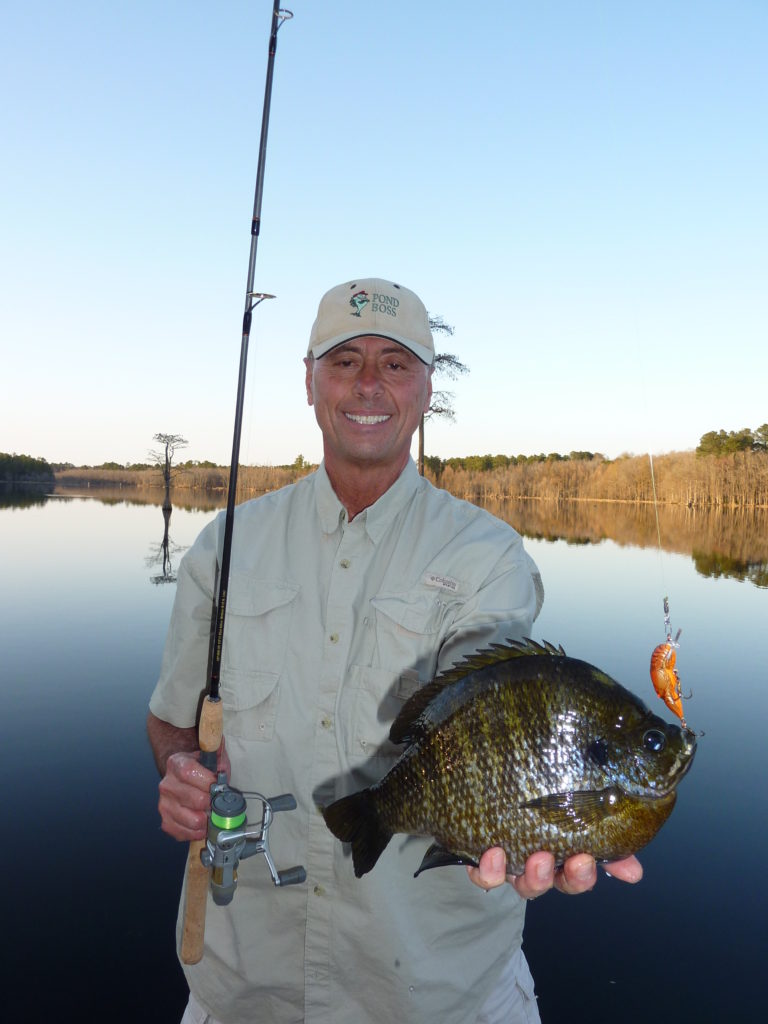
Today, ponds are planned, thought about and designed. Everything from building the dam to designing the perfect habitat for different species of fish is part of the plan…before the dirt guy comes out.
To learn more about how to build the perfect pond or lake, check out How to get the Perfect Pond.
Part of that ever-evolving method also involves how people feed their fish. New technology and new, specialized feeds allow pondmeisters the opportunity to have a feeding program.
Consider this…your goal is to have a healthy, well balanced fishing pond. You want to grow big bass, maybe a few catfish and some of those really big bluegills you have been reading about. Tilapia may play a role in your plan for part of the year. After all, they eat algae and have lots of babies that feed your bass.
You’ve read about those feed-trained bass and it’s time to give them a shot in your four acre pond.
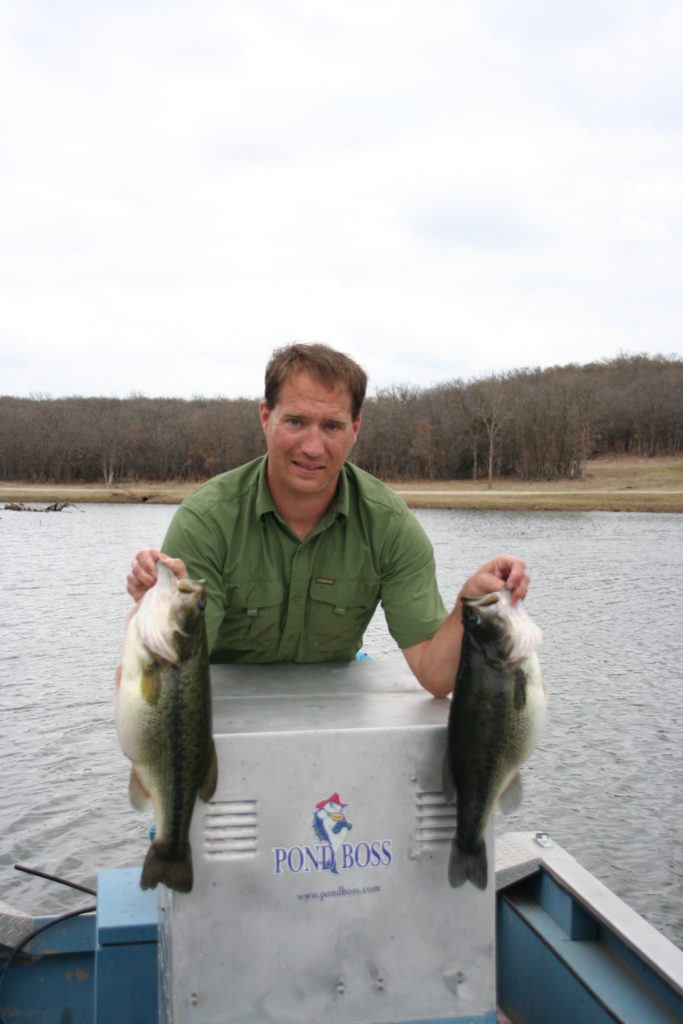
Feeding is one part of managing a pond, to learn more about Pond Management check out another great article by Bob Lusk, Managing your Pond.
A thoughtful feeding program involves taking care of different sizes of different species in their own niches in your pond. For example, you have some shallow water where baby fish are spotted from time to time, darting in and out of the safety of dense aquatic plants. Just beyond, you see larger fish that look like bluegills, just at the edge of those plants, in two to three feet of water. Beyond that…a swirl…a big bass chasing baitfish.
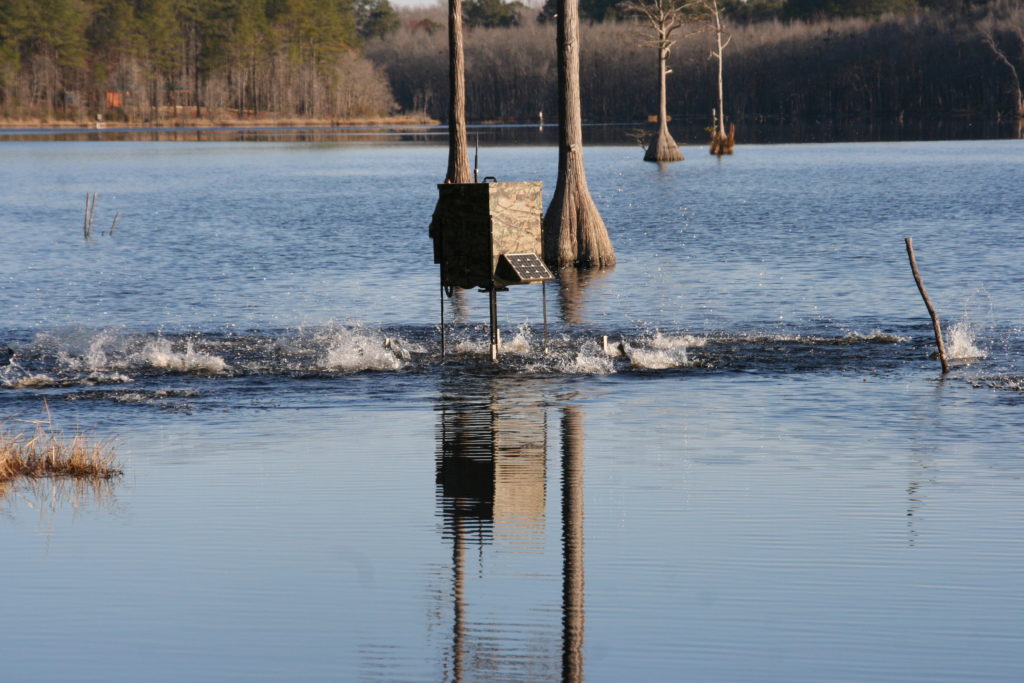
You can feed those small fish, the medium sized ones and in the case of feed-trained bass, the large ones.
Selecting a feed for you fish in a pond
Quite a few feed mills make fish food. Those are good quality products, but it’s our job to figure out what will help you meet your goals. A few years ago, people would buy day-old bread and feed it to their catfish.
Then, when it was time to eat said catfish, their texture was mushy and they had a different taste than we might expect. Bread isn’t designed for fish. Choose the best feed for the situation.
Enter Purina Mills. Back in 1996, yours truly had a meeting with several of the higher-ups in the specialty feed division of Purina. Those guys saw a budding pond management business and wanted to do their part to help by developing good feeds. Fast forward almost 20 years and they have done just that.
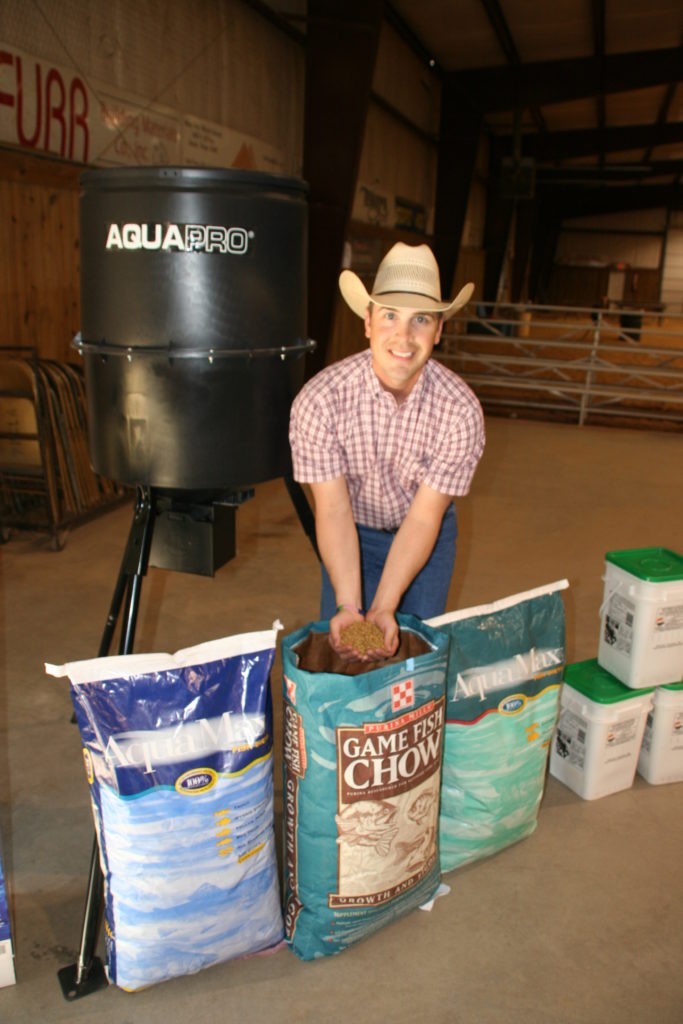
What do you feed fish in a pond?
| Desired Fish to Feed | Best Feed Choice |
| Small Bluegill | Purina Aquamax 500 |
| Large Bluegill and Small Bass | Purina Aquamax 600 |
| Large Feed Trained Bass | Purina Aquamax Largemouth |
| Catfish | Purina Omnivore Variety |
| Feeding for fun? | Purina Game Fish Chow |
What to feed Bluegill in a Pond
If you want to feed small bluegills and get them on the fast track to giant sizes, feed them AquaMax 500. That’s a fish meal-based, high protein feed designed to give young fish an advantage and expedite their growth rates far beyond the offerings of Mother Nature in your pond.
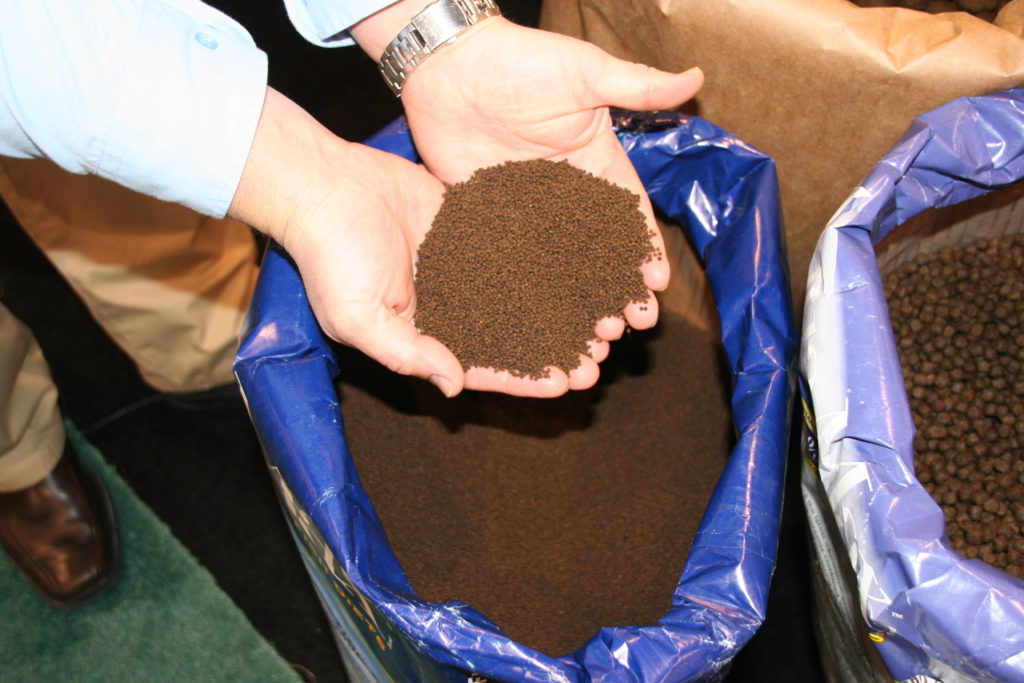
What to feed large Bluegill and small Bass in a Pond
Want to feed your biggest bluegills and maybe some one pound feed trained bass? AquaMax 600 is the ticket. It’s the same formula as 500, but the pellets are larger.
What to feed Largemouth Bass in a Pond
If you want the best bang for the buck while feeding bigger feed-trained bass, AquaMax Largemouth is the ticket.
What to feed Catfish in a Pond
Are catfish your bag? Feed a grain-based feed. That’s one of the “omnivore” diets Purina offers. Feeding just for fun? Game Fish Chow is a good choice, because it’s got multiple particle sizes.
Are there other companies who make good feed for fish? You bet. But, it’s your job to read the tags and make sure the top two or three ingredients are what your fish need in order to have the best nutrition.
Designing a fish feeding program for your pond or lake
Here’s the skinny on how to design a feeding program. Choose the right feeds…that’s job one. The “right” feed is based on your goals. If you have a weekend place and there’s a feeder on the dock and your main goal is to attract some fish and growth rates aren’t that important to you, choose one of the grain-based feeds.
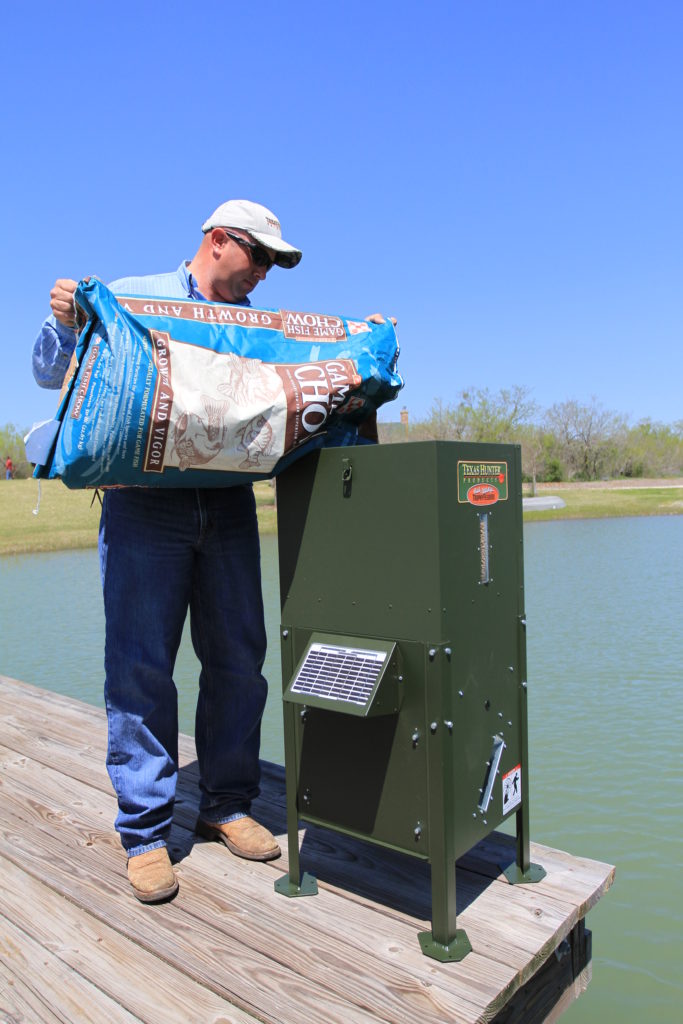
If you are feeding catfish, they don’t need those high-powered, high protein feeds. They’ll do quite well with the grain-based feeds. But, if you want to put some weight on bluegill or feed-trained bass, don’t sell them short on their food. They are meat-eaters, athletes of the underwater world. Give them a good, fish meal-based feed.
An example of an excellent fish feeding program
At Richmond Mill Lake, home of the King Fisher Society (www.kingfishersociety.com) we have designed arguably the best feeding program in the nation. Yes, it’s a larger lake…125 acres. Yes, it’s a commercial operation attracting people who pay to come. Yes, there’s a budget for all this. But, for this story, it’s the principles behind what we are doing there that are your take home points.
What’s being done there can be done on a much smaller scale.
In the shallow areas, adjacent to bluegill spawning beds, there are vibratory feeders, designed to dispense tiny feed for newly hatched fish. Peripherally, there are directional feeders which throw AquaMax 600, targeting larger bluegill and small feed-trained bass. Sitting on platforms in deeper water are scatter feeders which dispense those huge nuggets of AquaMax Largemouth to the behemoths of the lake…feed-trained bass pushing beyond eight pounds now.
How to set your feeding program up for success
For your pond, feeding the small fish makes sense because they are your up and coming stars, the freshman team, if you will. Feeding the medium size critters sets the table for those fish to be the junior varsity, on their way to the big time.
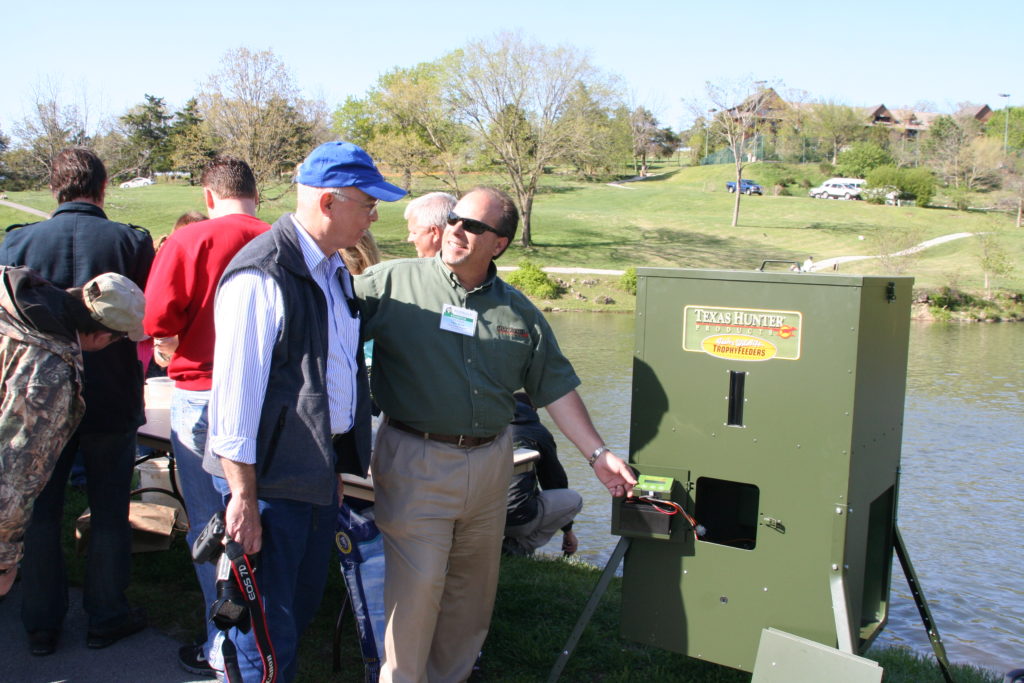
So, in today’s world of fisheries management, you have a number of choices. Feed for fun, feed to grow big fish or design a program to mix it up and feed different sizes of different species of fish to speed up Nature’s process and to grow fish well beyond those sizes you might ordinarily see in a normal pond.
Today’s world isn’t like it was 30 years ago. Today, you have a menu for your pond, just like the rest of our lives.
So, the next time you drive by a store with the checkerboard on the outside, know that inside those doors is someone who can help with your pond’s menu. Talk to them about it. If what you want isn’t on their floor, have them order it.
After all, you are on a mission and a feeding program might just be what you need to bump up your pond and its fish to the level you’ve wanted for years.
